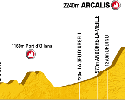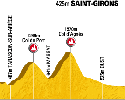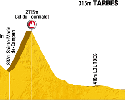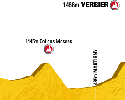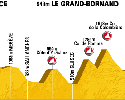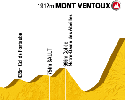
Recently on Cyclingnews.com |
96th Tour de France - GT
France, July 4-26, 2009
Elaborate and audacious, topsy-turvy Tour should be wide open to the wire
By Ben Atkins in Paris
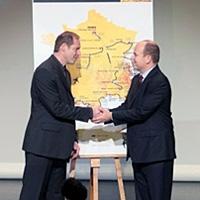
|
After the so-called modest parcours of the previous edition, the 2009 Tour de France will be anything but. From the longer-than-usual 15km opening time trial around the streets of the millionaires' paradise of Monte Carlo, the final destination of the maillot jaune ought to be wide open right up to the final day thanks to a sting in the tail the like of which has not been seen in the Tour before.
"Beyond the prestige associated with the Principality," reflected Tour Director Christian Prudhomme, "the Tour start from Monaco was an immediate landmark attraction: being located in the south-east, it provoked the most intense curiosity as to the envisaged route and favoured audacity in the elaboration of the course."
This has certainly been achieved, and the traditional early stage territories of northern and western France have been avoided completely. The only time the race travels north of a diagonal line drawn southwest to northeast will be the final day's entrance to Paris.
The 2009 Tour parcours is also the most international for many years; starting as it does outside France in the Principality of Monaco, the route also passes through Spain, Andorra, Switzerland and Italy. Additionally, due to the southern position of the Grand Départ, the clockwise route will see the race tackle the Pyrénées first, just as the anti-clockwise route did last year.
As introduced last year, there are to be no time bonuses on the line for stage winners – or at intermediate sprints. The Tour will instead be measured in real time, with the time that riders cross the line to be the one taken. As Tour organiser ASO put it: "Official time remains the absolute reference". This real time also extends to the re-introduced team time trial, back for the first time since 2005. No longer will slower teams be able to rely on the limited time penalties imposed in previous years; time lost on the line will translate to time lost in the overall classification.
The return of the team time trial has a knock-on effect on the rest of the kilometres against the clock. Despite the longer opening test, the total individual time trials are reduced to just 55km – the least since the 52.3km in 1967 – with the third race against the clock in its traditional final week position. This could have disastrous implications for any overall hopefuls who are strong against the clock, but whose team is traditionally weak; Silence-Lotto's Cadel Evans springs immediately to mind here, but team acquisitions over the winter may help to remedy this.
The 15km stage 1 (at more than 8km it is too long to be called a prologue) gives TT specialists a real chance to put real time into climbers in a stage twice as long as usual. The first real rendezvous though will be the stage 4 team time trial where the more powerful teams will try to put pressure on lesser ones. Most of the rest of the early stages likely give little room to challenge for the overall classification; while many of the rolling roads offer opportunities for the breakaway specialists, it is unlikely that the teams of the still-fresh sprinters will let anyone escape for a stage win.
A slight uphill finish onto the heights of Montjuic in Barcelona at the end of stage 6 ought to provide the puncheurs – more than likely the Spanish ones – a chance to take a few seconds. The stage 7 finish at Andorra-Arcalis, where Jan Ullrich so decisively took yellow in 1997, should provide the first opportunity for the leading riders to go mano a mano and force real gaps to appear.

|
Two further Pyrénéen stages into Saint-Girons and Tarbes should prove to be little more than leg-stretchers to the overall contenders – despite the second one featuring the cols d'Aspin and du Tourmalet – as both finish at the end of long downhill and flat sections. With the first rest day in Limoges just around the corner though, some unfancied hopefuls might try for a bit of temporary glory and claim a few days in yellow before the race hits the Alps.
Stages 10, 11 and 12 should give the breakaway riders a chance to for victory, but these cross-country, transitional stages are also some of the few opportunities for the sprinters this side of Paris, so escapists may not be allowed their day in the sun.
Stage 13 provides a taster of the days to come as it passes through the medium mountains of the Vosges. While the highest climb of the day is the 1193m col de Piatzerwasel, the steepness of the roads could outweigh the relative lack of altitude and prove tougher than it first looks. The Alps proper begin on the following day though as stage 14 heads for the uphill finish at Verbier, Switzerland for the second mountain top finish of the race.
Following the second rest day, the Tour heads back to France on stage 16, via the northwest corner of Italy. Taking in the cols de Grand Saint-Bernard and Petit Saint-Bernard, the fast descent into Bourg-Saint-Maurice could provide the opportunity for time gaps as big as those on an uphill finish. Stage 17 the following day takes in five climbs in 169km including the tricky Col de la Colombière as it heads to the finish at La Grand Bornand.
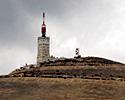 |
With the Alps behind them the peloton tackles the final time trial, but three days earlier than would be usual; falling as it does on a Thursday rather than the final Saturday of the most recent editions. A very picturesque 40km loop around the lac d'Annecy gives the time trial specialists their last chance to gain time on the climbers with what is to come at the weekend.
After one more transitional stage taking the course away from the Alps, the last, and probably biggest rendezvous of the race arrives. Stage 20 from Montelimar to Mont Ventoux is the stage that ASO hopes will keep the race wide open right to the finish. Even a seemingly insurmountable lead can be lost on a bad day on the legendary bald mountain, and after today there's no time to take it back before Paris.
The days before should see the strange situation of time trial specialists nervously trying to accumulate enough time on the climbers heading into the final weekend rather than the more usual other way around. Very often, the rider in yellow atop Ventoux is the rider who wears yellow to Paris; this year, barring accident or scandal, this will definitely be true.
The Mountains
Tour de France presentation photos
For a thumbnail gallery of these images, click here
Images by AFP Photo
- Monaco welcomed in 2009: Tour Director Christian Prudhomme and Prince Albert II of Monaco at the 2009 Tour de France launch, l-r.
- Tour Director Christian Prudhomme speaks at the 2009 Tour de France launch.
- France's Christian Prudhomme presents the 2009 Tour de France.
- Crowd gathered for the 2009 Tour de France launch.
- Britain's David Millar gives his comment on the 2009 Tour route.
- Former French cycling champion Raymond Poulidor, r, sits next to Dutch champion Jopp Zoetemelk at the 2009 Tour de France route launch.
- Tour Director Christian Prudhomme presents the 2009 Tour de France launch.
- President Amaury Sports Organisation (ASO), Jean-Etienne Amaury at the 2009 Tour presentation.
Images by John Pierce/Photosport International
- 2008 Tour champion Carlos Sastre
- Carlos Sastre speaks with 2007 Tour champion Alberto Contador, l-r.
- Spaniards Carlos Sastre and Alberto Contador at the 2009 Tour route presentation.
- 2007 Tour de France winner Alberto Contador, r, chats with Carlos Sastre.
- Astana Team Manager Johan Bruyneel at the 2009 Tour launch.
- Belgian Johan Bruyneel looks on at the 2009 Tour launch.
- The 2009 Tour parcours.
- Spain's Alberto Contador at the 2009 Tour route launch.
- Carlos Sastre is the 2008 Tour de France champion.
- A view of the Tourmalet that the Tour will cover in 2009.
- The Mont Ventoux is back for 2009.
- The famed Mont Ventoux will come on the Tour's penultimate day.
- Crowds gathered for the 2009 Tour de France launch.
- Tour director Christian Prudhomme addresses the crowd.
- Carlos Sastre, Alberto Contador and Oscar Pereiro, l-r, all past winners and all at the 2009 Tour de France launch.
- Sprinter Mark Cavendish watches for sprint stages
- The Grand Départ in Monaco.
- Paris marks the end of the 2009 parcours.
- The time trial around Monaco.
- Stage two's parcours.
- A look at stage five.
- Stage six will head into Spain.
- A mountain top finish for stage seven to Andorra.
- Stage 17 will be another mountain day.
- The final time trial.
- Mount Ventoux appears on the penultimate day of the 2009 Tour.

